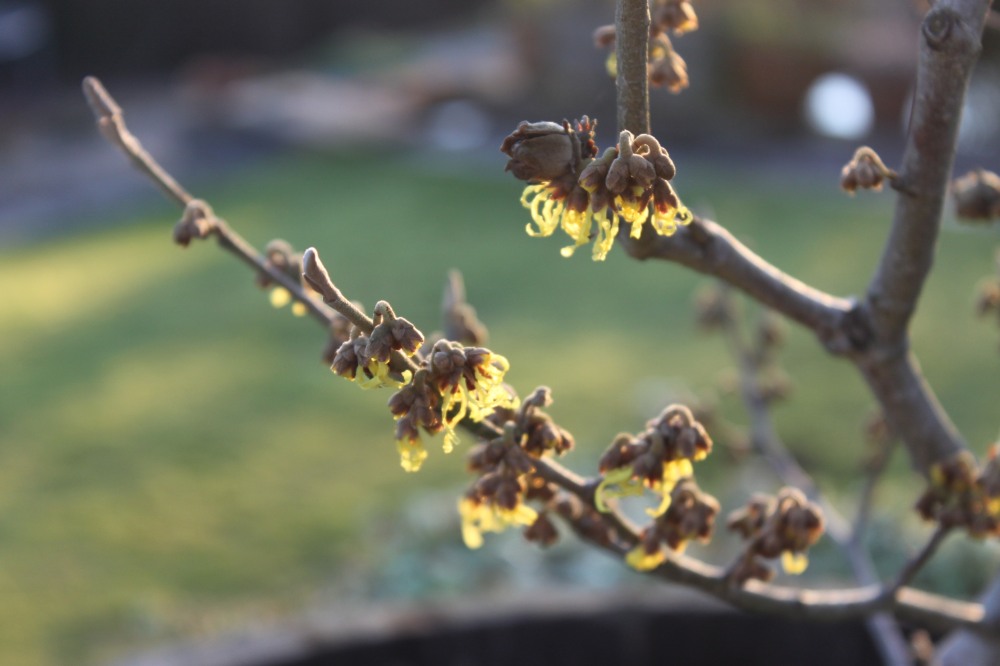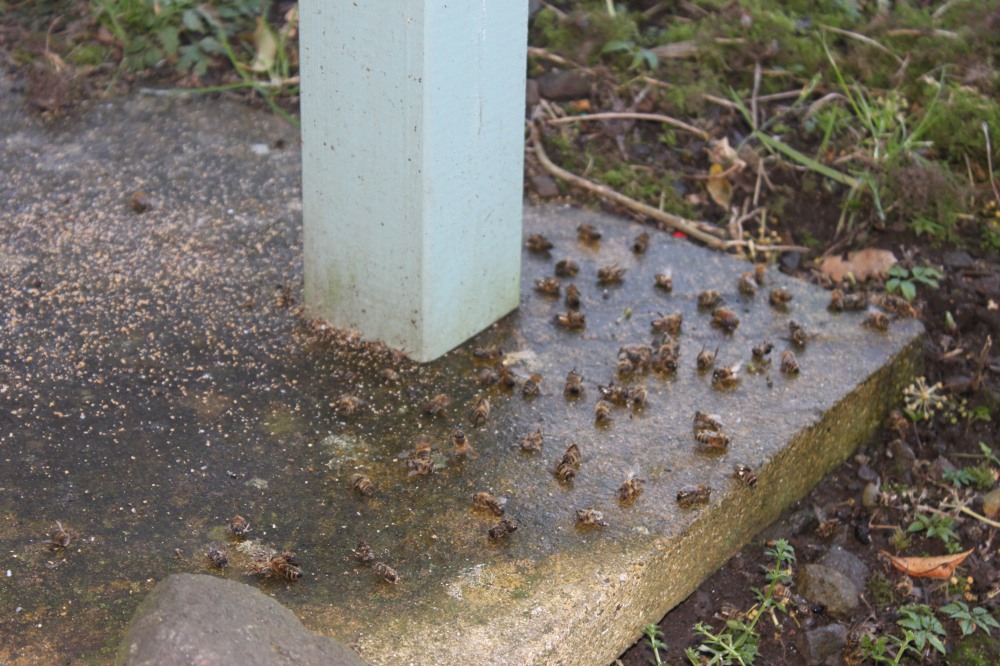Another mild week and we have still suffered very few frosts this winter. February can often be the cruelest month in the garden though so we are certainly not through the worst yet. There was a time not so long ago when a mild winter like this would be met with a sense of relief or good fortune. Now though that feeling is tinged with a slightly ominous awareness of how our climate is changing. The effects of this may be relatively minor in this part of the world just now but not so elsewhere. Even here though there are barometers of change all around us.
Six on Saturday is a weekly garden diary form all over the world, hosted over at the propagator blog.
1) Hamamelis
One of the curious aspects of looking at other garden diaries is that you get a glimpse of the near future by peeking into gardens further south. Perhaps Norwegian gardeners would have the same feeling looking upon a Scottish garden. It may be another fortnight or so before the witch hazels are all in full bloom here. By which time everyone else will have moved on to daffodils and so it goes.

2) Last summer’s borders
I still haven’t gotten round to clearing some parts of the flower borders. To be honest when the sun is reflecting off the golden dried grasses I am inclined to leave them a while longer. At some point before the bulbs and weeds come up they may need to be shorn but perhaps not just yet.

3) The bees are waking up
I found myself pausing for a rest fairly often when I was getting the last stumps out of the old hedge in the front garden. It was hard work but I was encouraged enormously by seeing the honey bees out flying one afternoon. It is the first time this year I have noticed them. They are not through the worst of winter yet by any means. I suspect they were mostly on ‘orientation’ or ‘cleansing’ flights as there is very little if any nectar or pollen available to forage round here just now. It is also dangerously close to being too cold for them outside of the hive.

You might think that it is the cold weather that kills off honeybees but in someways it can be worse if we get a mild spell. The warmth encourages the winter cluster of bees to break up, which means they have to expend more energy maintaining their temperature. If nature isn’t providing any food for them then they will rapidly consume their own stores between January and March and potentially starve. To try and minimise this risk colonies are left with a block of bakers fondant on top of the frames. Seeing the bees out I had a very brief look under the lid and it appears that I was just in the nick of time. One of the hives was down to their last few morsels so I hastily replaced this with fresh block.

The other colony was less strong going into the winter and their fondant was untouched. This either means that they have adequate stores and are still in a cluster and all is well. Or alternatively the bees in that hive could be nearly wiped out in which case there is nothing to be done just now. We won’t know until the spring arrives. If we see large numbers of bees going in and out and bringing in pollen then that will be a good sign.

4) Pruning fruit trees
A really enjoyable job but few of the fruit trees in the garden are in need of much pruning. There are a couple of young apple trees in half barrels though that were given to me a couple of years ago by someone who had grafted them herself. One of them is definitely in need of some formative pruning now to improve its shape and potential for producing fruit. Some of the long whips growth will need to be cut back to encourage more side shoots.

5) Sarcococca*
A definite success this year for their scent. There are pots of sarcococca at the side door and others are planted in the borders at the front step and along the path. Half a dozen all together. A very pleasant aroma as you step out in the morning or stroll down the path.

6) The first seeds of the year
Bitter experience has taught me that it is unwise to get too excited sowing seeds early in the year up here. It is not the warmth that is necessarily a problem as seeds can be started indoors or under heat but the lack of daylight tends to make them spindly and weak. Much better to wait until March or later for the majority of seeds. There are some exceptions though and chillis are traditionally the first seeds to be started for me in January. These are followed by sweet peas (autumn sowings have been disappointing for me for the same reason), garlic and broad beans. A slow and gentle start but it will start to accelerate in the coming weeks…

* I always have to remind myself how to spell sarcococca (“winter box’ is much easier to remember). It is also the only word that I can think of that uses the letter ‘c’ four times. To my surprise I have discovered with a bit of research that there are in fact 43 words that contain the letter ‘c’ four times. Today’s special schoolhouse gold star award goes to anyone who can think of one without looking it up!
If you would like to follow the schoolhouse garden please click on the button at the bottom of this page. Worpdress promises to store your email address securely and I will only send you bunches of flowers and not any nasty weeds.
No I have no idea about any word with 4 “c’s!” I love reading about your bees!
LikeLiked by 1 person
Thanks. I think everyone else is stumped too. Maybe a word will pop into your head without thinking!
LikeLike
I’ve loved reading about your bees. I did a beekeeping course 4 years ago and was so keen but then for various reasons never took the plunge. It always surprised me that baker’s fondant was a good food for them. It’s not my favourite icing for a cake so all the better to feed it to the bees!
LikeLiked by 1 person
Hi Katharine. I think the idea of using fondant in the winter is that it doesn’t tend to freeze solid and is relatively easy for the bees to digest but its really just a backup to their own supplies. Maybe you should have a go with the bees this year? It isn’t really that much work for most of the year and it has certainly made me think differently about gardening and the wider ecology.
LikeLike
That is a really interesting write up about the bees Keith. Thank you
LikeLiked by 1 person
Thanks. Hopefully they will get through the winter in good enough condition to make the most of the spring flowers – it feels like they aren’t that far away…
LikeLiked by 1 person
I enjoyed learning about your bees and what’s involved in looking after them. I hope they come through the winter safely.
LikeLike